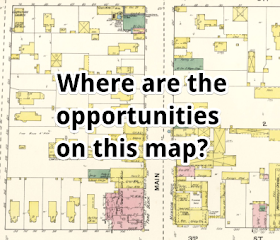 |
| Excited to open... but not quite yet. |
Twelve days ago, we started the two-week countdown to opening Abbott Square. We sent out hundreds of flyers with the eight-night Opening Week schedule. We lined up press. We shifted staff schedules. We had 2,000 t-shirts to give away, 850 balls to drop, and over a hundred artists, accordionists, salsa dancers, taiko drummers, and bubble ladies ready to go.
Ten days ago, we called it all off.
Why? The reason is simple: we weren’t ready. Abbott Square is a plaza, a garden, and a marketplace with 6 restaurants and 2 bars. Marketplace construction isn’t complete. All those chefs haven’t had a chance to stock their food or train their staff. We know food and drink are essential parts of Abbott Square. They are worth the wait. And so, at the last moment, we pulled the rip cord and postponed the events.
The more interesting question is this: why did it take so long to make this decision?
I knew for months that construction was delayed. I knew for weeks that we weren’t going to be able to do all the restaurant prep we had planned for. Why didn’t I make the decision to postpone sooner?
I think the answer comes down to three things.
1. I was too optimistic.
Leading an entrepreneurial project requires a lot of optimism. For years, I’ve been a cheerleader, fundraiser, and spokesperson for this project. When people were skeptical of the vision three years ago, it was my job to win them over. When we needed funds two years ago, it was my job to inspire people to give. When staff were unsure how it would change their jobs a year ago, it was my job to get colleagues onboard. And now in construction, I’ve been telling the community how great the project will be when it opens.
And let’s be clear: it WILL be great. But my realist brain never got the full attention of my cheerleader brain. Partly, I was inexperienced; when construction managers gave me a date, I figured they knew more than I did. But considering how often those dates slid, I should have seen the writing on the wall sooner. I should have taken a break from cheerleading to identify the likely outcome of the trend of construction delays.
2. We had a hard opening date instead of a go/no go threshold.
Back in March, I asked our market partner when he thought construction would be done. He said April 15. And then they’d want two weeks of soft opening - May 1. We added a month to be safe and agreed to have a big grand opening June 2-9. Once we locked this in, I focused on those dates, driving towards them, cranking to get done in time. I felt that a reasonable goal would focus us to get to a successful opening. As that goal became unreasonable, instead of adjusting, I dug in harder. I pushed to open on time, and got more and more stressed as it seemed like we might not hit our dates. By the time of that key decision, I’d barely slept in days.
How could we have avoided this? Instead of pushing to hit a date, I wish I had defined thresholds for a quality grand opening, like “we must have a Certificate of Occupancy at least three weeks prior” or “chefs must have at least 2 weeks to train/soft open.” If I had taken that tack, we would have postponed sooner.
3. It felt easier to commit to dates than to embrace ambiguity.
I felt pressure, both in myself and within our staff team, to provide a date. We are pros at event planning at the MAH, but all event plans start the same way: with a date. It felt like we needed to lock in a date so we could book collaborators, schedule staff, market the activities, and plan everything. So we did. We picked dates we thought were extremely safe… until they weren’t. When construction delays started to get too close to June 2, we started reframing the events—calling them “previews” instead of “opening.” Ultimately, even this reframing wasn’t going to fly, and we had to postpone.
Weirdly, once we decided to postpone, it seemed much less overwhelming than I expected to move everything. Now it feels like we have an amazing event-in-a-box ready to go whenever we are able to lock in new dates. That fixation on dates may have been unhelpful from the start.
I am so grateful to our staff, board, and community for supporting this change. I made the mistake, and they made the solution work. Our staff did an amazing job communicating the change with press, members, and partners—even shifting a huge cover story that went to print just hours after we made the change. Our team clearly, quickly told everyone about the change, and we emphasized that we were postponing so we could offer members the best experience possible. People were understanding about the delay and excited about the opening to come. And I went back to sleeping at night... while spending my days working hard to make the project live up to our community's biggest dreams.
Have we reset new opening dates? Heck no! Here’s our new strategy:
- We’ll host an Abbott Square Preview Night on June 2 as part of First Friday activities.
- When the Market gets its Certificate of Occupancy, we will work with the Market management to determine how many weeks of training and soft opening they need to open successfully. We'll start soft opening our new programming in the plaza during this period too.
- We’ll set new grand opening dates based on soft opening needs and fire up our events plan with a few tweaks.
Please share your questions or comments! If you are reading this via email, you can join the conversation here.



